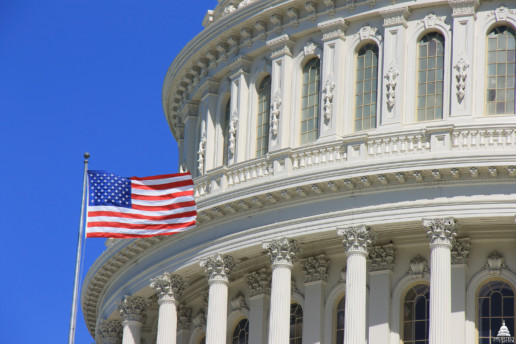3 Aspects of the GOP Healthcare Plan that Demand Employers’ Attention
The House of Representatives last week passed the American Health Care Act (AHCA) bill to begin the process of repealing the ACA. Find out what this new legislation means for employers in the great article from Employee Benefits Adviser by Daniel N. Kuperstein.
The extremely emotional journey to repeal (more appropriately, to “change”) the Affordable Care Act reached a significant milestone this week: The Republican-led House of Representatives passed an updated version of the American Health Care Act. While more than 75% of the provisions of the ACA remain intact, the AHCA gutted or delayed several of the ACA’s taxes on employers, insurers and individuals.
So what does this mean for employers?
First off, it’s important to remember that this new bill is not law just yet. The House version of the bill now heads to the Senate, where there’s no guarantee that it will pass in its current form; the margin for victory is much slimmer there. Only three “no” votes by Senate Republicans could defeat the bill, and both moderate and conservative Republican lawmakers in the Senate have expressed concerns about the bill. In other words, employers don’t have to do anything just yet, but it’s still beneficial to understand the major changes that could be coming down the pike.
As employers know from working over the last seven years to implement provisions of the ACA, there will be a million tiny details to work through if the AHCA becomes law.
But for now, we see three major aspects that demand employers’ attention.
There will be more emphasis on health savings accounts
Under the AHCA, health savings accounts will likely become far more popular — and more useful. The HSA contribution limits for employers and individuals are essentially doubled. Additionally, HSAs will be able to reimburse over-the-counter medications and allow spouses to make catch-up contributions to the same HSA. Of course, with this added flexibility comes increased responsibility — there will be a greater need for employees to understand their insurance.
There will be more flexibility in choosing a benchmark plan
For larger employers not in the small group market, the AHCA creates an opportunity to choose a benchmark plan that offers a significantly lower level of benefits to employees.
Currently, the ACA provides that employer-sponsored self-insured health plans, fully-insured large group health plans, and grandfathered health plans are not required to offer EHBs. However, these plans are prohibited from imposing annual and lifetime dollar limits on any EHBs they do offer. For purposes of determining which benefits are EHBs subject to the annual and lifetime dollar limits, the ACA currently permits employers sponsoring these types of plans to define their EHBs using any state benchmark plan. In other words, employers are not bound by the essential health benefits mandated by their state and can pick from another state’s list of required benefits.
Under the AHCA, we may see a big change to how the rules on annual and lifetime limits work. Notably, nothing in the AHCA would prohibit employers from choosing a state benchmark plan from a state that had obtained an AHCA waiver, which would allow the state to put annual and lifetime limits on its EHBs. This means that, if one state decides to waive these EHB requirements, many employers could decide to use that lower-standard plan as their benchmark plan. Of course, while choosing such a benchmark plan may benefit an organization by lowering its costs, such a move may have a negative impact on its ability to recruit and retain the best talent.
There will be a greater need to help employees make smart benefits decisions
The most important aspect of this for employers is to understand the trend in health insurance, which is undeniably moving in the direction of consumerism.
The driving philosophy behind this new Republican plan is to place more responsibility on individuals. However, this doesn’t mean employers can throw a party and simply wish their workers “good luck” — employers need to think at a macro level about what’s good for business. In a tightening labor market in which so many talented people consider themselves free agents, smart employers will focus on helping employees to make smart decisions about their health insurance.
See the original article Here.
Source:
Kuperstein D. (2017 May 5). 3 aspects of the GOP healthcare plan that demand employers attention [Web blog post]. Retrieved from address https://www.employeebenefitadviser.com/opinion/3-aspects-of-the-gop-healthcare-plan-that-demand-employers-attention
Advisers Seek Innovative Ways To Increase Retirement Savings
Are you struggling to save for your retirement? Check out this great article from Employee Benefits Adviser on what employee benefits advisers are doing to help their clients prepare for their retirement by Cort Olsen.
In a recent forum co-hosted by Retirement Clearinghouse, EBRI, Wiser and the Financial Services Roundtable, experts shared how automated retirement portability programs could be the key to increased participation in private-sector retirement plans.
Today, at least 64% of Americans say they do not have sufficient funds for retirement and less than half of private-sector workers participate in workplace retirement programs. Former U.S. Sen. Kent Conrad, a Democrat from North Dakota, says these statistics could improve through better access to workplace retirement savings plans.
“So many small businesses tell [Congress], ‘Look we’d like to offer a plan, but we just can’t afford it,’” Conrad says. “We take the liability off of their shoulders, we take the administrative difficulty off their shoulders and allow a third party to administer the plans, run the plans and have the financial responsibility for the plans, which makes a big difference for employers.”
With these improved access points to savings plans, Conrad says the opportunity arises to create new retirement security plans for smaller businesses with fewer than 500 employees, enabling multiple employers — even from different industries — to band together to offer their workers low cost, well-designed options.
“Once the [savings plan] has been put in place for a period of time, we then introduce a nationwide minimum coverage standard for businesses with more than 50 employees,” Conrad says. “Any mandate is controversial, but legally if you dramatically simplify (don’t require employer match) really all they have to do is payroll deduction, and then it becomes not unreasonable for employers with 50 or more workers to offer some kind of plan.”
How to achieve auto-portability
Once plans have been made available for employers of all sizes, Jack VanDerhei, research director for the Employee Benefit Research Institute, recommends three different scenarios for auto-portability of retirement plans between employers.
1) Full auto-portability. VanDerhei considers this to be the most efficient scenario, where every participant consolidates their savings in their new employer plan every time they change jobs. The goal would be that all participants arrive at age 65 with only one account accumulated over the span of their working life.
2) Partial auto-portability. In this scenario, every participant with less than $5,000 — indexed for inflation — consolidates their savings in their new employer plan every time they change jobs. “If you have $5,000 or less in your account balance at the time you change jobs, leakage would only come from hardship withdrawals,” VanDerhei says. This means that money would only leave the account if the participant determined it necessary to take money out to pay for a necessity.
3) Baseline: status quo. In addition to hardship withdrawals, there is a participant-specific probability of cashing out and loan default leakage at the time of job transition. These participant specific leakages can be age, income, account balance and how long the participant has been with the employer.
VanDerhei says the younger the participants are to begin using full auto-portability of retirement plans, the more likely they are to get the most out of their retirement savings once they reach the age of 65.
“If you look at people who are currently between the ages of 25 and 34, under a partial portability there is a chance for accumulation to reach $659 billion and under a full portability there is a chance to reach $847 billion in accumulation,” VanDerhei says. “As you would expect, accumulation will decrease as the age increases if they choose to enter into auto-portability later in life.”
Spencer Williams, president and CEO of Retirement Clearinghouse, LLC, says although retirement portability has been codified into ERISA there are not enough mechanisms involved to encourage participants to continue to save for retirement rather than cashing out.
“We have a little more than a third of the population cashing out when they change jobs,” Williams says. “The research shows that if you fix that problem, the difficulty moving peoples’ money, we will begin the process of reducing leakage.”
Once a retirement account reaches a certain amount, Williams adds that participants will begin to take the account more seriously and have more desire to continue investing in the plan.
“We need to create an efficient and effective means by which people can have their money moved for them, and in doing that we begin to change peoples’ behavior,” Williams says. “Finally, if we increase access and coverage, along with auto-portability, all of those benefits accrue from all those new participants in the system.”
See the original article Here.
Source:
Olsen C. (2017 April 6). Advisers seek innovative ways to increase retirement savings [Web blog post]. Retrieved from address https://www.employeebenefitadviser.com/news/advisers-seek-innovative-ways-to-increase-retirement-savings
Employers Want Lawmakers to Curb Rising Pharma Costs
Has the cost of pharmaceuticals caused an increase in your health care costs? Find out how other employers are trying to combat rising costs in the great article from Employee Benefits News by Nick Otto.
A majority of employers say they were relieved to see the GOP’s repeal and replace plan fizzle out last month, and instead have their own ideas on how to best reform healthcare and how to rein in costs.
In a poll conducted by Mercer days following the crumbling of the American Health Care Act, more than half who invest in employer-sponsored healthcare said they were happy to see the GOP plan fail.
Nearly a quarter (24%) of employers told the consulting firm they “very relieved” of the legislation’s failure, while 32% said they were “relieved.”
Meanwhile, 16% said they were disappointed the legislation didn’t pass, 5% were “very disappointed” it didn’t pass, and the remainder of employers had no opinion. A planned vote on the ACHA was scrapped in late March at President Donald Trump’s request after a number of Republicans said they opposed the bill.
With more than 61% of covered Americans getting health coverage through employer plans, Mercer says businesses should help play a key role in recognizing and addressing the underlying cost concerns plaguing the healthcare market.
“Cost-shifting does not address the underlying causes of healthcare cost growth, and increasing burdens on employers will simply make it harder for them to provide affordable coverage to their employees,” Mercer says.
So what do employers say are the top issues lawmakers should address?
Topping the employer wish list, according to the Mercer poll, is help with controlling the climbing cost of pharmaceuticals with a score of 4.4/5 (employers ranked policymaker priorities 1-5, 5 being “top priority).
The following improvements also made the list of employer desires: improving price transparency (4.1), stabilizing the individual markets (4), maintaining Medicaid funding (4) and investing more in population health and education (3.7).
While neither the ACA nor the AHCA had any significant impact to how employers offer healthcare, there are aspects of both legislations that would still influence some employer plans.
Maintaining Medicaid funding and having a stabilized individual market will lower hikes to private payers by allowing people not in employer-sponsored plans have access to affordable coverage and avoid a rise in the number of uninsured.
See the original article Here.
Source:
Otto N. (2017 April 9). Employers want lawmakers to curb rising pharma costs [Web blog post]. Retrieved from address https://www.benefitnews.com/news/employers-want-lawmakers-to-curb-rising-pharma-costs?brief=00000152-14a7-d1cc-a5fa-7cffccf00000
5 Benefits Communication Mistakes That Kill Employee Satisfaction
Are you using the proper communication channels to inform your employees about their benefits? Take a look at this great article from HR Morning about how to manage to communicate with your employees to keep them satisfied at work by Jared Bilski.
Good benefits communication is more important than the actual benefits you offer – at least when it comes to employee satisfaction.
Proof: When a company with a rich benefits program (i.e., better than industry standard) communicated poorly, just 22% of workers were satisfied with their benefits.
On the other hand, when an employer with a less rich benefits program communicated effectively, 76% of employees were satisfied with the benefits.
These findings come from a Towers Watson WorkUSA study.
At the at the 2017 Mid-Sized Retirement & Healthcare Plan Management Conference in Phoenix, AZ., Julie Adamik, the former head of Employee Benefits Training and Solutions at PETCO, highlighted the five most common benefits communication mistakes that put firms in the former category.
Satisfaction killers
1. The information is boring. Many employees assume that if the info is about benefits, it’s probably boring. As a result, they tend to tune out and miss critical material.
2. The learning styles and preferences of different generations aren’t taken into account. With multiple generations working side-by-side, a one-size-fits-all approach is doomed to fail.
3. The budget is too low. If your company has a $15 million benefits package, you shouldn’t accept upper management’s argument that a $2,500 communication budget should cover it. HR and benefits pros need to take a stand in this area.
4. The language is “too professional.” Assuming that official-sounding language is better than “plain speak” is a common but costly communication mistake.
5. There’s too much information being covered. Cramming everything into a single open enrollment meeting is guaranteed to overwhelm employees.
Cost, wellness, personal issues and care
Employers also need to be wary of relying too heavily on tech when it comes to benefits communication. Even though there are plenty of technological innovations in the world of benefits services and communications, but HR pros should never forget the importance of old-fashioned human interaction.
That’s one of the main takeaways from a recent Health Advocate study that was part of the whitepaper titled “Striking a Healthy Balance: What Employees Really Want Out of Workplace Benefits Communication.”
The study broke down employees’ preferred methods of benefits communications in a number of areas. (Note: Employees could select more than one answer.)
When asked how they preferred to receive health cost & administrative info, the report found:
- 73% of employees said directly with a person by phone
- 69% said via a website/online portal, and
- 56% preferred an in-person conversation.
Regarding their wellness benefits:
- 71% of employees preferred to receive the info through a website/online portal
- 62% said directly with a person by phone, and
- 56% preferred an in-person conversation.
In terms of personal/emotional wellness issues:
- 71% of employees preferred to receive the info directly with a person by phone
- 65% preferred an in-person conversation, and
- 60% would most like to receive the info via a website/online portal.
Finally, when it came to managing chronic conditions:
- 66% of employees preferred to receive the info directly with a person by phone
- 63% would most like to receive the info via a website/online portal, and
- 61% preferred an in-person conversation.
See the original article Here.
Source:
Bilski J. (2017 April 4). 5 benefits communication mistakes that kill employee satisfaction [Web blog post]. Retrieved from address https://www.hrmorning.com/5-benefits-communication-mistakes-that-kill-employee-satisfaction/
Do You Know What Your Retirement Plan Is?
"People don’t plan to fail they fail to plan. Retirement is about what you want out of life, what do you need to do to sustain the lifestyle you have become accustomed too? Unfortunately, most people in America never really retire because they have not planned properly. Retirement is a process that begins in your 20s, 30s, 40s.” - Garry Rutledge, Saxon Partner.

The biggest hurdle of retirement is getting something started. Getting a start on retirement early in life will provide a massive amount of appreciation over time. Even if only a small amount is put away early in life, compound interest will do much of the work. Here are some other ways to begin building your retirement funds.
20s
In your 20s, time is your biggest ally when it comes to saving for retirement. Many people in their twenties are just getting out of school and excited to live life rather than thinking about putting something away for retirement that seems so far down the road.
Investigate any company options
Consider employer sponsored plans available- 401k, 457, 403(b) – different sectors of the economy have different company sponsored retirement plans.
Know where you are headed.
- Only 48% of people have even bothered trying to figure out how much they need to retire comfortably, according to the Employee Benefit Research Institute's 2015 Retirement Confidence Survey.
- The rule of 72 is a math rule that determines how long it will take to double funds for any given rate of return. The amount returned divided by 72 would be the amount of time it takes to double your money. Ex. If your money is in a savings account earning three percent a year, it will take twenty-four years to double your money (72/3=24).
- A Roth is a type of retirement account that grows tax free meaning you only pay taxes on the money going into the account.
- "I would heavily encourage a Roth, I am very pro Roth IRA versus the traditional tax deferred plan,” Garry advised. “The best analogy I can make to this is: 'would you rather pay taxes on the crop you harvest or would you rather pay taxes on the seeds you plant?' What this really means is that you can take a small handful of seeds and plant a crop that will amount to a huge harvest."
30s
It is about late 30s when people begin to realize retirement is not that far away. This is the time in life that people are thinking about beginning families and having kids, it is also the point in life that you can start understanding what realistic retirement goals look like. "In my 28 years of experience," Garry explained, "most people don't start planning for retirement until their late 30s." Whether you're already saving or just starting now, carrying good habits throughout your 30s can pay off in the future.
Company sponsored plans are key
- If you are just beginning in 30s, consider company sponsored plans that will have a match of a percentage of one’s salary. That translates into a 100% return on your money and you haven't done any investing yet.
- If you are already contributing into your company's plan, make small increases each year to work towards your savings goal.
Keep it balanced
- "The 'perfect retirement plan' would have the perfect balance of pretax contributions, meaning before tax qualified plans and after tax contributions (brokerage accounts or Roth IRAs) allow both plans to complement each other."
College is important, but retirement comes first
- A lot of people try to begin planning for their children's college at this point but retirement planning should come before planning for college. After all, people won't lend you money to retire with.
40s/50s/60s
The biggest thing at this point in life is "Do you know what your plan is and are you on track?" If you build a house, you start with a plan. Same is true for retirement.
This is the time to be deciding if you are on track for retirement. Do you have a plan and a budget? Have you created a financial plan? Do you know how you want to retire? Your perspective of what retirement looks like is truly your reality.
The closer you get to 65, the retirement age, more alarms that are beginning to go off. If you haven't done anything at this point you must take a serious look at what your plans are
Slow and Steady
- If you've been planning and following a plan, keep up the good work! The only way to eat an elephant is one bite at a time.
If you have not begun planning...
- Time isn't your ally at this point.
- You will have to be more aggressive in your strategies.
- Again, the most beneficial thing you can do is seek out company plans with matches.
Know your alternatives
• A thing to consider that most people don't plan for is long term care. This is a good option to explore because it is still cheap enough in your 50s to afford.
• Consider how social security will play into your financial plan. Make sure you maximize your social security benefit.
• Have you changed your investment risk to meet your risk tolerance? As you get older your investments cannot generally tolerate the same amount of risk. The sequence of returns in retirement can devastate your retirement plan.
Seek professional help and guidance
- Saxon takes a holistic approach to planning.
- Company sponsored plan approach
- While Saxon does not benefit from any contributions to your company plan, they know that this is the best place for a client's money to be.
- Saxon can help you stay on track and give sound investment advice
- Company sponsored plan approach
"The advisors at Saxon can help you create a plan for the future and offer suggestions on how to invest money," explained Garry. "Asking for help is one of the best things you can do – people are busy – and developing a plan and having a ‘coach’ to make sure you stick to the plan when things seem bleak will reward you over time”.
To download the full article click Here.
The 10 Biggest 401(k) Plan Misconceptions
Do you know everything you need to know about your 401(k)? Check out this great article from Employee Benefit News about the top 10 misconceptions people have about their 401(k)s by Robert C. Lawton.
Unfortunately for plan sponsors, 401(k) plan participants have some big misconceptions about their retirement plan.
Having worked as a 401(k) plan consultant for more than 30 years with some of the most prestigious companies in the world — including Apple, AT&T, IBM, John Deere, Northern Trust, Northwestern Mutual — I’m always surprised by the simple but significant 401(k) plan misconceptions many plan participants have. Following are the most common and noteworthy —all of which employers need to help employees address.
1. I only need to contribute up to the maximum company match
Many participants believe that their company is sending them a message on how much they should contribute. As a result, they only contribute up to the maximum matched contribution percentage. In most plans, that works out to be only 6% in employee contributions. Many studies have indicated that participants need to average at least 15% in contributions each year. To dispel this misperception, and motivate participants to contribute something closer to what they should, plan sponsors should consider stretching their matching contribution.
2. It’s OK to take a participant loan
I have had many participants tell me, “If this were a bad thing why would the company let me do it?” Account leakage via defaulted loans is one of the reasons why some participants never save enough for retirement. In addition, taking a participant loan is a horribleinvestment strategy. Plan participants should first explore taking a home equity loan, where the interest is tax deductible. Plan sponsors should consider curtailing or eliminating their loan provisions.
3. Rolling a 401(k) account into an IRA is a good idea
There are many investment advisers working hard to convince participants this is a good thing to do. However, higher fees, lack of free investment advice, use of higher-cost investment options, lack of availability of stable value and guaranteed fund investment options and many other factors make this a bad idea for most participants.
4. My 401(k) account is a good way to save for college, a first home, etc.
When 401(k) plans were first rolled out to employees decades ago, human resources staff helped persuade skeptical employees to contribute by saying the plans could be used for saving for many different things. They shouldn’t be. It is a bad idea to use a 401(k) plan to save for an initial down payment on a home or to finance a home. Similarly, a 401(k) plan is not the best place to save for a child’s education — 529 plans work much better. Try to eliminate the language in your communication materials that promotes your 401(k) plan as a place to do anything other than save for retirement.
5. I should stop making 401(k) contributions when the stock market crashes
This is a more prevalent feeling among plan participants than you might think. I have had many participants say to me, “Bob, why should I invest my money in the stock market when it is going down. I'm just going to lose money!” These are the same individuals who will be rushing into the stock market at market tops. This logic is important to unravel with participants and something plan sponsors should emphasize in their employee education sessions.
6. Actively trading my 401(k) account will help me maximize my account balance
Trying to time the market, or following newsletters or a trader's advice, is rarely a winning strategy. Consistently adhering to an asset allocation strategy that is appropriate to a participant's age and ability to bear risk is the best approach for most plan participants.
7. Indexing is always superior to active management
Although index investing ensures a low-cost portfolio, it doesn't guarantee superior performance or proper diversification. Access to commodity, real estate and international funds is often sacrificed by many pure indexing strategies. A blend of active and passive investments often proves to be the best investment strategy for plan participants.
8. Target date funds are not good investments
Most experts who say that target date funds are not good investments are not comparing them to a participant's allocations prior to investing in target date funds. Target date funds offer proper age-based diversification. Many participants, before investing in target date funds, may have invested in only one fund or a few funds that were inappropriate risk-wise for their age.
9. Money market funds are good investments
These funds have been guaranteed money losers for a number of years because they have not kept pace with inflation. Unless a participant is five years or less away from retirement or has difficulty taking on even a small amount of risk, these funds are below-average investments. As a result of the new money market fund rules, plan sponsors should offer guaranteed or stable value investment options instead.
10. I can contribute less because I will make my investments will work harder
Many participants have said to me, “Bob, I don’t have to contribute as much as others because I am going to make my investments do more of the work.” Most participants feel that the majority of their final account balance will come from earnings in their 401(k) account. However, studies have shown that the major determinant of how much participants end up with at retirement is the amount of contributions they make, not the amount of earnings. This is another misconception that plan sponsors should work hard to unwind in their employee education sessions.
Make sure you address all of these misconceptions in your next employee education sessions.
See the original article Here.
Source:
Lawton R. (2017 April 4). The 10 biggest 401(k) plan misconceptions[Web blog post]. Retrieved from address https://www.benefitnews.com/opinion/the-10-biggest-401-k-plan-misperceptions?brief=00000152-14a5-d1cc-a5fa-7cff48fe0001
Half of Mature Workers Delaying or Giving Up on Retirement
Did you know that now more than ever Americans are giving up on their dreams of retirement? Find out about the somber facts facing the older generation of workers in the great article from Benefits Pro by Marlene Y. Satter.
It’s a grim picture for older workers: half either plan to postpone retirement till at least age 70, or else to forego retirement altogether.
That’s the depressing conclusion of a recent CareerBuilder survey, which finds that 30 percent of U.S. workers aged 60 or older don’t plan to retire until at least age 70—and possibly not then, either.
Another 20 percent don’t believe they will ever be able to retire.
Why? Well, money—or, rather, the lack of it—is the main reason for all these delays and postponements.
But that doesn’t mean that workers actually have a set financial goal in mind; they just have this sinking feeling that there’s not enough set aside to support them.
Thirty-four percent of survey respondents aged 60 and older say they aren’t sure how much they’ll need to save in order to retire.
And a stunning 24 percent think they’ll be able to get through retirement (and the potential for high medical expenses) on less than $500,000.
Others are estimating higher—some a lot higher—but that probably makes the goal of retirement seem even farther out of reach, with 25 percent believing that the magic number lies somewhere between $500,000–$1,000,000, 13 percent shooting for a figure between $1–2 million, 3 percent looking at $2 million to less than $3 million and (the) 1 percent aiming at $3 million or more.
And if that’s not bad enough, 26 percent of workers 55 and older say they don’t even participate in a 401(k), IRA or other retirement plan.
With 74 percent of respondents 55 and older saying they aren’t making their desired salary, that could play a pretty big part in lack of participation—but that doesn’t mean they’re standing still. Eight percent took on a second job in 2016, and 12 percent plan to change jobs this year.
Predictably, the situation is worse for women. While 54.8 percent of male respondents aged 60+ say they’re postponing retirement, 58.7 percent of women say so.
Asked at which age they think they can retire, the largest groups of both men and women say 65–69, but while 44.9 percent of men say so, just 39.6 percent of women say so.
In addition, 24.4 percent of women peg the 70–74 age range, compared with 21.1 percent of men, and 23.2 percent of women agree with the gloomy statement, “I don’t think I’ll be able to retire”—compared with 18 percent of men.
And no wonder, since while 21.7 percent of men say they’re “not sure” how much they’ll need to retire, 49.3 percent of women are in that category.
Women also don’t participate in retirement plans at the rate that men do, either; 28.3 percent of male respondents say they don’t participate in a 401(k), IRA or other retirement plan, but 35.4 percent of female respondents say they aren’t participating.
For workers in the Midwest, a shocking percentage say they’re delaying retirement: 61.6 percent overall, both men and women, of 60+ workers saying they’re doing so.
Those in the fields of transportation, retail, sales, leisure and hospitality make up the largest percentages of those putting off retirement, at 70.4 percent, 62.5 percent, 62.8 percent and 61.3 percent, respectively. And 46.7 percent overall agree with the statement, “I don’t think I’ll be able to retire.”
Incidentally, 53.2 percent of those in financial services—the largest professional industry group to say so—are not postponing retirement.
They’re followed closely by those in health care, at 50.9 percent—the only other field in which more than half of its workers are planning on retiring on schedule.
And when it comes to participating in retirement plans, some industries see some really outsized participation rates that other industries could only dream of. Among those who work in financial services, for instance, 96.5 percent of respondents say they participate in a 401(k), IRA or comparable retirement plan.
That’s followed by information technology (88.2 percent), energy (87.5 percent), large health care institutions (85.8 percent—smaller health care institutions participate at a rate of 51 percent, while overall in the industry the rate comes to 75.5 percent), government employees (83.6 percent) and manufacturing (80.2 percent).
After that it drops off pretty sharply, and the industry with the lowest participation rate is the leisure and hospitality industry, at just 43.4 percent.
See the original article Here.
Source:
Satter M. (2017 March 31). Half of mature workers delaying or giving up on retirement [Web blog post]. Retrieved from address https://www.benefitspro.com/2017/03/31/half-of-mature-workers-delaying-or-giving-up-on-re?ref=mostpopular&page_all=1
5 Simple Steps Clients Can Take to Boost Workers' Financial Wellness
Are you trying to help your employees increase their financial well-being? Check out these 5 great tips from Employee Benefits Adviser on how to help increase your employees' investment into their financial wellness by Joe Desilva.
Now more than ever, employers offer a wide array of benefits to build engagement and culture within their walls. Healthy snack options adorning the kitchen? Check. Fitness stipends? Check. Competitive work-from-home policies? Check. These are all nice-to-have extras, but employees are increasingly concerned about a more fundamental concern: retirement planning. And it’s here where employers are not providing enough enticing options as they are with the other, flashier perks.
One of the biggest issues employees face as they plan for retirement is economic uncertainty. Only 21% of workers are very confident that they will have enough money for a comfortable retirement, according to the 2016 Employee Benefit Research Institute Retirement Confidence Survey. This should matter to employers because financial uncertainty can have a negative effect on work performance, according to a study by Lockton Retirement Services. The study found that one in five workers reported feeling extremely stressed, mostly because of their job or finances, and those reporting high stress were twice as likely to report poor health overall, leading to more sick days and decreased productivity.
Boosting financial wellness programs not only can help employees’ finances in the long term, it can possibly help employees manage stress and increase productivity in the short term. Employers seem to understand this. In fact, 92% of employer-respondents in a study commissioned by ADP titled Winning with Wellness confirmed interest in providing their workforce with information about retirement planning basics, and 84% said the same of retirement income planning.
Yet, even though many employers appreciate the value of these programs, 32% are not considering implementation. The appetite exists for retirement planning, but the prospects of starting a program appear to be daunting. The truth is, it can be easier than you think.
Here are five simple steps an employer can take to start helping employees find tools and information to help them better manage their finances and grow more confident in their financial futures.
- Teach employees critical planning skills. Experts suggest retirees will need 75%-90% of their working income to live comfortably in retirement. To help employees determine the optimal amount to meet their needs, consider providing them with tools that look at factors such as current annual pre-tax income, estimated Social Security benefit amount, current age and the age they would like to retire, and any retirement savings and project possible retirement savings outcomes. Helping them estimate savings needs and retirement investing now can pay off in the future.
- Offer access to automatic enrollment and auto-escalation features. No matter how well employees do with other investments, the 401(k)’s advantages of tax-deferred growth and a company match is likely unbeatable. By automatically enrolling employees in retirement plans with savings increases, you may be able to position your employees for a more confident financial future.
- Provide resources so employees can seek investment advice from a professional. Employees may want to seek advice on their investments so they will not bear the stress of retirement on their own. There are a lot of options available to employees, but they may not be familiar enough with those options to determine whether or not they’d benefit. Providing access to professional investment advice with respect to retirement accounts may help employees feel confident in their retirement decisions.
- Deliver tools and personalized materials that integrate with real data. Working with a service provider that integrates payroll and recordkeeping data can give a retirement plan the ability to deliver targeted personalized information that employees can use for planning purposes. By delivering relevant information, employees can get engaged and have a better sense of the progress of their retirement planning.
- Make self-learning tools available for honing financial skills anytime, anywhere. A financial wellness program can help employees face their financial decisions with confidence. Most programs offer a library of tools and resources that gives employees access to information about planning, saving, and providing for their home, family and retirement. With financial education, employees may make better financial choices and set realistic goals.
At a time when employee retention is crucial, it’s important to create a support system for employees as they plan their financial futures. With so many workers concerned about retirement security, employers have a clear opportunity to step in and help. Whether it’s enabling employees to save more for retirement or learn about budgeting, financial planning can potentially serve as another popular perk among that list of nice-to-haves.
See the original article Here.
Source:
Desilva J. (2017 March 16). 5 simple steps clients can take to boost workers' financial wellness[Web blog post]. Retrieved from address https://www.employeebenefitadviser.com/opinion/5-simple-steps-clients-can-take-to-boost-workers-financial-wellness
How Employers Should Proceed After the AHCA’s Collapse
Take a look at the great article from Employee Benefits Advisor on what employers need to know about healthcare with the collapse of the AHCA by Alden J. Bianchi and Edward A. Lenz.
The stunning failure of the U.S. House of Representatives to pass the American Health Care Act has political and policy implications that cannot be forecasted. Nor is it clear whether or when the Trump administration and Congress will make another effort to repeal and replace, or whether Republicans will seek Democratic support in an effort to “repair,” the Affordable Care Act. Similarly, we were unable to predict whether and to what extent the AHCA’s provisions can be achieved through executive rulemaking or policy guidance.
Here are some ways the AHCA’s failure could impact employers in the near term.
Immediate impact on employers
Employers were not a major focus of the architects of the ACA, nor were they a major focus of those who crafted the AHCA. This is not surprising. These laws address healthcare systems and structures, especially healthcare financing. Rightly or wrongly, employers have not been viewed by policymakers as major stakeholders on those issues.
In a blog post published at the end of 2014, we made the following observations:
The ACA sits atop a major tectonic plate of the U.S. economy, nearly 18% of which is healthcare-related. Healthcare providers, commercial insurance carriers, and the vast Medicare/Medicaid complex are the law’s primary stakeholders. They, and their local communities, have much to lose or gain depending on how healthcare financing is regulated. The ACA is the way it is largely because of them. Far more than any other circumstance, including which political party controls which branch of government, it is the interests of the ACA’s major stakeholders that determine the law’s future. And there is no indication whatsoever that, from the perspective of these entities, the calculus that drove the ACA’s enactment has changed. U.S. employers, even the largest employers among them, are bit players in this drama. They have little leverage, so they are relegated to complying and grumbling (not necessarily in that order).
With the AHCA’s collapse, the ACA remains the law of the land for the foreseeable future. The AHCA would have zeroed out the penalties on “applicable large” employers that fail to make qualified offers of health coverage, but the bill’s failure leaves the ACA’s “play or pay” rules in full force and effect. The ACA’s reporting rules, which the AHCA would not have changed, also remain in effect. This means, among other things, that many employers, especially those with large numbers of part-time, seasonal, and temporary workers that face unique compliance challenges, will continue to be in the position of “complying and grumbling.”
This does not mean that nothing has changed. The leadership of the Departments of Health and Human Services, Labor and Treasury has changed, and these agencies are now likely to be more employer-friendly. Thus, even though the ACA is still the law, the regulatory tone and tenor may well be different. For example, although the current complex employer reporting rules will remain in effect, the Treasury and IRS might find administrative ways to simplify them. Similarly, any regulations issued under the ACA’s non-discrimination provisions applicable to insured health plans (assuming they are issued at all) likely will be more favorable to employers than those issued under the previous administration.
There are also unanticipated consequences of the AHCA’s failure that employers might applaud. We can think of at least two.
1. Stemming the anticipated tide of new state “play or pay” laws
The continuation of the ACA’s employer mandate likely will put on hold consideration by state and local governments of their own “play or pay” laws.
In anticipation of the repeal of the ACA’s employer mandate, the Governor of Massachusetts recently introduced a budget proposal that would reinstate mandated employer contributions to help cover the costs of increased enrollment in the Medicaid and Children’s Health Insurance Program, known as MassHealth. Under the proposal, employers with 11 or more full-time equivalent employees would have to offer full-time employees a minimum of $4,950 toward the cost of an employer group health plan, or make an annual contribution in lieu of coverage of $2,000 per full-time equivalent employee. While the Governor’s proposal is not explicitly conditioned on repeal of the ACA’s employer mandate, the ACA’s survival may prompt a reconsideration of that approach.
California lawmakers were also considering ACA replacement proposals, including a single-payer bill introduced last month by Democratic state senators Ricardo Lara and Toni Atkins. Had the ACA’s employer mandate been repealed, those proposals were likely just the tip of an iceberg. When the ACA was enacted in 2010, Hawaii, Massachusetts, and San Francisco were the only jurisdictions with their own healthcare mandates on the books. But in the prior two-year period, before President Obama was elected and made healthcare reform his top domestic priority, more than two dozen states had introduced various “fair share” health care reform bills aimed at employers.
Most of the state and local “play or pay” proposals would have required employers to pay a specified percentage of their payroll, or a specified dollar amount, for health care coverage. Some required employers to pay employees a supplemental hourly “health care” wage in addition to their regular wages or provide health benefits of at least equal value. California, Illinois, Pennsylvania, and Wisconsin considered single-payer proposals.
To be sure, any state or local “play or pay” mandates would be subject to challenge based on Federal preemption under the Employee Retirement Income Security Act (ERISA). While some previous “play or pay” laws were invalidated under ERISA (e.g., Maryland), others (i.e., San Francisco) were not. In sum, given the failure of the AHCA, there would appear to be no rationale, at least for now, for any new state or local “play or pay” laws to go forward.
2. Avoiding upward pressure on employer premiums as a result of Medicaid reforms
The AHCA proposed to reform Medicaid by giving greater power to the states to administer the Medicaid program. Under an approach that caps Medicaid spending, the law would have provided for “per capita allotments” and “block grants.” Under either approach, the Congressional Budget Office, in its scoring of the AHCA, predicted that far fewer individuals would be eligible for Medicaid.
According to the CBO: CBO and JCT estimate that enacting the legislation would reduce federal deficits by $337 billion over the 2017 to 2026 periods. That total consists of $323 billion in on-budget savings and $13 billion in off-budget savings. Outlays would be reduced by $1.2 trillion over the period, and revenues would be reduced by $0.9 trillion. The largest savings would come from reductions in outlays for Medicaid and from the elimination of the ACA’s subsidies for non-group health insurance.
While employers rarely pay attention to Medicaid, the AHCA gave them a reason to do so. Fewer Medicaid-eligible individuals would mean more uncompensated care — a significant portion of the costs of which would likely be passed on to employers in the form of higher premiums. As long as the ACA’s expanded Medicaid coverage provisions remain in place, premium pressure on employers will to that extent be avoided.
Long-term impact on employers
As we conceded at the beginning, it’s not clear how the Republican Congress and the Administration will react to the AHCA’s failure. If the elected representatives of both political parties are inclined to try to make the current system work, however, we can think of no better place that the prescriptions contained in a report by the American Academy of Actuaries, entitled “An Evaluation of the Individual Health Insurance Market and Implications of Potential Changes.”
The actuaries’ report does not address, much less resolve, the major policy differences between the ACA and the AHCA over the role of government — in particular, the extent to which taxpayers should be called on to fund the health care costs of low-and moderate-income individuals, and whether U.S. citizens should be required to maintain health coverage or pay a penalty. And even if lawmakers can reach consensus on those contentious issues, they still would have to agree on the proper implementing mechanisms.
But whatever the outcome, employers are unlikely to play a major role.
See the original article Here.
Source:
Bianchi A. & Lenz E. (2017 April 6). How employers should proceed after the AHCA's collapse [Web blog post]. Retrieved from address https://www.employeebenefitadviser.com/opinion/how-employers-should-proceed-after-the-ahcas-collapse
HSAs to see explosive growth
Are you using HSAs to help save money on your healthcare cost? Find out from this article by Employee Benefit News on how the market for HSAs is set to grow exponentially over the next few years by Kathryn Mayer.
It’s about time for health savings accounts to take the spotlight. And that’s going to be a good thing for employees, industry experts say: Not only will HSAs help workers with their healthcare expenses, but the savings vehicles also will put them on a better track for retirement planning.
“The market is going to blow up,” American Retirement Association CEO Brian Graff said this week during the NAPA 401k Summit in Las Vegas, citing new healthcare reform proposals — including the GOP’s American Health Care Act — as well as a better understand of HSAs as reasons for the predicted growth.
The ACHA, which doubles HSA contributions, “dramatically increases the incentive for employers to offer high-deductible health plans,” he said. The GOP plan expands the allowable size of healthcare savings accounts that can be coupled with high-deductible insurance plans, up to $6,550 for an individual or $13,100 for a family. It also expands qualifying expenses to include health insurance premiums, over-the-counter medications and preventive health costs.
By 2018, there will be 27 million HSA accounts and more than $50 billion in HSA assets, according to estimates from the Kaiser Family Foundation cited by Graff. Currently, there are 18 million accounts and $34.7 billion in assets.
Those statistics — and proposed healthcare reforms — are catching the eye of the retirement industry: The accounts have the potential to become “more compelling than a 401(k),” due to tax-deductible and tax-deferred incentives, Graff said.
“We have to think about what this means for our industry,” he said.
In a live poll during a conference keynote, three-quarters of retirement advisers noted they do not offer HSA advisory services. That number, Graff predicts, will change radically over the next two years.
Current proposals are positioning HSAs a hybrid of medical and retirement savings, Graff said. “It’s not just a health account, it’s a savings account.” Healthcare expenses are a major concern for retirees and often cause employees to push back plans for retirement. If HSA funds are not needed for medical expenses, the money can be withdrawn after age 65 and taxed as ordinary income.
Graff says plan sponsors and retirement advisers should encourage employees to first max out their HSAs and then match their 401(k)s.
The HSA is “the nexus between healthcare and retirement,” Daniel Bryant, an advisor with Sheridan Road, said during a standing-room only panel on HSAs Monday.
Meanwhile, added panelist Ryan Tiernan, a national accounts manager with American Funds, “it’s the biggest jump ball no one has cared to jump to. HSAs are probably the most efficient way to save and invest for your biggest expense in retirement.”
See the original article Here.










